Using organic controls in the greenhouse is much easier than in the great outdoors. With regular care and a bit of patience, your rewards include healthier, chemical-free plants, more change in your pocket, and the satisfaction of knowing that you’re doing something great for your environment.
Make time for preventative hygiene
The best way to prevent future problems is to inspect all your plants carefully before you bring them into the greenhouse. Look closely at their leaves (especially the underside), stems and the soil they are potted in. A quality, lighted magnifier is an essential for this job. Check underneath pot rims and on the bottom of containers for slugs and snails. Make it a regular habit to watch for all of the above while you’re caring for your greenhouse plants weekly.
Common Unwanted Insects & Controls
Maria Rodale, in her beautifully written book,
Organic Gardening, wisely noted, “Pest bugs are actually our messengers. Not only are they a concern, but they may point to a larger problem in our greenhouse or garden – poor soil, drought stress, weak plants.” Look for the additional message pests may be pointing out to you as you stomp out those pesky bugs!
- Ants
Controls: Destroy with boiling water. Plant pennyroyal, spearmint or tansy to repel. - Aphids – Tiny, pear-shaped, often light green in color. Adults may be winged or wingless. Aphids suck sap, excreting a honeydew, sticky substance. They cause wilting and curling of leaves and flowers.
 Controls: For small infestations, wipe with soapy water and use Whitefly & Aphid Traps. For larger infestations, spray frequently with soapy water or a product such as 70% Neem Oil. Plant pennyroyal, spearmint, tansy or garlic to repel. Ladybugs are also very effective.
Controls: For small infestations, wipe with soapy water and use Whitefly & Aphid Traps. For larger infestations, spray frequently with soapy water or a product such as 70% Neem Oil. Plant pennyroyal, spearmint, tansy or garlic to repel. Ladybugs are also very effective. - Mealy Bugs – These sapsuckers are often confused with aphids and produce a wax-like cottony substance that looks like cotton on your plant. They are white to tan and oval in shape. Find them particularly near buds, on leaf bases, and leaf veins.
 Controls: For small infestations, wipe with a Q-tip or cotton ball that has been dipped in rubbing alcohol. For larger infestations, spray with 70% Neem Oil. A good beneficial beetle control is the “mealybug destroyer” – Cryptolaemus montrouzieri.
Controls: For small infestations, wipe with a Q-tip or cotton ball that has been dipped in rubbing alcohol. For larger infestations, spray with 70% Neem Oil. A good beneficial beetle control is the “mealybug destroyer” – Cryptolaemus montrouzieri. - Brown Scale – There are many different species of scale that can inhabit a greenhouse, but Brown Scale is the most common. These tiny, soft-shelled, flat insects attach themselves to plant stems and leaves. They are pale yellow when immature but later darken to brown. Find them often along the stem, leaf vein, and leaf stem as well as the leaf. Notorious for multiplying FAST, they weaken plants by sucking juices from the stem.
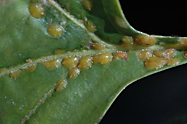 Controls: Wipe them off with a cotton swab or cotton ball dipped in rubbing alcohol. Scrape them off carefully (so as to not damage plant) with your fingernail. Alternately, for larger infestations, spray with 70% Neem Oil.
Controls: Wipe them off with a cotton swab or cotton ball dipped in rubbing alcohol. Scrape them off carefully (so as to not damage plant) with your fingernail. Alternately, for larger infestations, spray with 70% Neem Oil. - Slugs, Snails – Slugs are slimy, soft-bodied pests. They are gray to brown to army green in color and up to 4″ long. Slugs leave a shiny trail of slime. They generally like to feed at night and on cloudy days. They love moist environments. Find them hidden under pots and trays, in rims of pots, on the ground, crawling up bench legs, under debris. Snails are similar in looks and habitat to slugs, however, they have a roundish shell. Both slugs and snails eat holes in leaves. They enjoy feasting on seedlings, tender starts and new young growth.
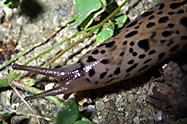 Controls: For a fun nighttime activity, take a flashlight into your greenhouse and you’ll find them feasting on your plants. Handpick them off, if you dare, and put them in a jar with rubbing alcohol. Or alternately get your kids or grandkids to do it …Slugs and snails are highly attracted to anything that is fermenting. I have had excellent luck filling Slug Hotels with cheap beer and placing them in strategic spots. They come running (well crawling fast) enter, enjoy the beer and drown happily.
Controls: For a fun nighttime activity, take a flashlight into your greenhouse and you’ll find them feasting on your plants. Handpick them off, if you dare, and put them in a jar with rubbing alcohol. Or alternately get your kids or grandkids to do it …Slugs and snails are highly attracted to anything that is fermenting. I have had excellent luck filling Slug Hotels with cheap beer and placing them in strategic spots. They come running (well crawling fast) enter, enjoy the beer and drown happily.
Or make your own beer traps. Sluggo Plus is also an attractive bait that causes them to quit eating and crawl away to die. Slug and Snail Copper Barrier Tape on the door threshold and around the base of bench legs stops them quickly from going further. Keep any debris picked up so they have no place to hide. - Spider Mites – These very tiny arachnids (8 legs) are impossible to see without a magnifier. They range from yellow to brown to reddish. Look for their telltale webs on the underside of leaves and at growing tips. They puncture leaves and suck the contents. Leaves become yellow and mottled.
Controls: Spray strong blasts of water on the underside of leaves to knock them off. They are encouraged by hot, dry conditions.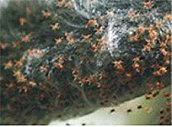 Spray water in the greenhouse regularly to create a more humid atmosphere. Use 70% Neem Oil or a similar product for larger infestations. Also there are a number of effective beneficial predatory mites available
Spray water in the greenhouse regularly to create a more humid atmosphere. Use 70% Neem Oil or a similar product for larger infestations. Also there are a number of effective beneficial predatory mites available
depending on your greenhouse temperature range and time of year. Check with Charley’s staff about your particular needs and we’ll be happy to help you. - Thrips – Very tiny, yellow to brown insects with a cigar-like shape. Find them on the underside of leaves, in flower buds and flowers. They begin their life in the soil and then surface and become winged. They can multiply and do much damage quickly! They feed on plant tissue through their mouths like little needles, resulting in silvery
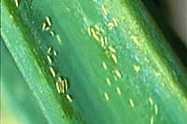 discoloration of leaves. They are also known for transmitting diseases including TSWV – tomato spotted-wilt virus.
discoloration of leaves. They are also known for transmitting diseases including TSWV – tomato spotted-wilt virus.
Controls: Spray with 70% Neem Oil.
Destroy badly infected plants. - Whitefly – Small, flying, translucent (maturing to become white) insects. All stages – eggs, immature crawlers and adults – suck sap from the underside of leaves. They can cause wilting, yellowing, spotty marks, deformation, and curling of leaves and flowers. Often they secrete a honeydew sticky substance on leaves and fruit; which in turn attracts a black, sooty mold.
 Controls: Gently sweep them up with a small vacuum cleaner. Spray with 70% Neem Oil. Use Whitefly & Aphid Traps to control adults. Encarsia Formosa, a small parasitic wasp, is a good beneficial insect control.
Controls: Gently sweep them up with a small vacuum cleaner. Spray with 70% Neem Oil. Use Whitefly & Aphid Traps to control adults. Encarsia Formosa, a small parasitic wasp, is a good beneficial insect control.
Common Diseases and Controls
There are no quick cures for plants having disease. The best choices include taking preventative measures to keep your greenhouse clean and growing plant varieties that are resistant to any particular disease you are concerned about. Changing any of the climate factors – temperature, light and humidity, moisture level and plant location are all excellent ways to reduce and control disease.
- Blossom End Rot – A tomato disease in which dark brown patch develops on the base of the tomatoes. Generally caused by uneven watering.
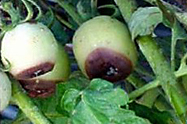
Controls: Keep the growing medium wet but not soggy. Avoid splashing water on the leaves and fruit. Increase air circulation and lower the humidity level. - Botrytis – Appears as a fluffy gray or brown mold on leaves and stems of soft-leaved plants. Associated with humid, cool weather conditions.
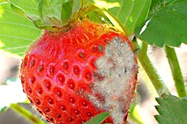
Controls: Remove all diseased areas, reduce watering and increase air movement. Spray with a product like GreenCure or Serenade. - Damping Off – Destructive fungi attack the roots and stems of seedlings causing rot. Seeds may decay in the soil and never germinate. Stems can rot at the surface and seedlings wilt and die. Roots can rot after the seedling has germinated and stunts it, then the plant dies. No cure.
Preventive Measures:
Use only sterile germination medium. Sow seeds thinly. Do not over water. Keep medium at recommended propagation temperature. - Mildews – Downy Mildew – A gray, downy substance that generally appears on the underside of leaves of seedlings, lettuce and cinerarias. Powdery Mildew – A white downy coating that appears on leaves and stems.
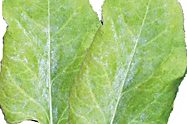 Controls: Remove badly affected plant parts. Spray with bicarbonate of soda (2 tsp. to 1 liter of water). Spray larger infestations with a product like GreenCure or Serenade. Improve ventilation.
Controls: Remove badly affected plant parts. Spray with bicarbonate of soda (2 tsp. to 1 liter of water). Spray larger infestations with a product like GreenCure or Serenade. Improve ventilation. - Rust – Appears as small, raised spots on the underside of leaves. Spots can range from dark brown to light orange.
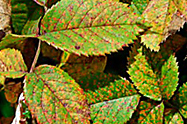 Controls:
Controls:
Remove affected leaves and destroy them. Spray with a product like GreenCure or Serenade. - Sooty Mold – A fungus that grows on the sticky honeydew excretions of many sap-sucking insects. Appears as black, sticky substance
on leaves.
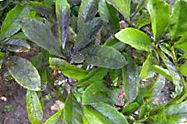 Controls:
Controls:
Spray with soapy water. Wipe with a damp cloth. Spray with a product like GreenCure or Serenade. Eliminate the cause – sucking insects such as aphids, mealybug, whiteflies.






